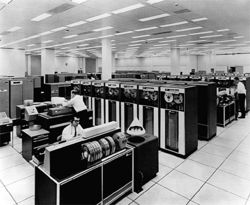
At its present market cap of $100 billion, Palantir has a price to earnings (PE) ratio of 263. You’re paying over 25 times revenue, there’s no dividend, and the growth rate is just 10%.
That’s why, while at InvestorPlace, I urged that investors not buy Palantir. It may not be the AI stock you’re looking for, I wrote.
In some ways I was right, but in more important ways I was wrong. Palantir may not be the AI stock you’re looking for. It may be overpriced.
But it may be worth buying on any dip.
Note: I am currently unemployed as a financial journalist, but if you need one just e-mail.
What Palantir Does

But Nabeel Qureshi, who worked there for 8 years and now runs a start-up, finally offered a coherent explanation of what they’re doing on his Substack recently.
There’s a lot of mumbo jumbo at Palantir, about belief structures and politics and whatnot. But it really comes down to commitment. Commitment to improving the productivity of each client company, commitment to tying that company to Palantir, and commitment to building Palantir’s data analysis tools. It’s the kind of Cold War “mission orientation” that no longer exists at companies devoted to their own success, rather than that of the customer.
Here’s how it works.
The Inside Job

An FDE gets inside a client enterprise. Like a journalist they learn all the “magic words” insiders use to define and explain it. They learn how data flows, but also how business flows and money flows. They focus on data integration.
Then they work against major pain points, using Agile methodology. When they need to program a new way of displaying or moving data, they write it. When Palantir has a tool to do the work, they use it. But they focus on the client’s needs, not those of Palantir. They look to deliver big hits of productivity in the flow and use of data.
Software vendors don’t do this because they’re devoted to their own tools. Consultants don’t do this because they’re devoted to their own processes. An FDE’s job is to become the client, while passing back the knowledge of what makes the client’s operation work.
The Outside Job

The PD folks turn what the FDE folks are doing into coherent products for moving data, for displaying data, and for generalizing the approach of the FDEs. Over time, the quick and dirty FDE solutions become part of the broader Palantir product. This includes Magritte for data ingestion, Contour for visualization, and Workshop for making web apps.
All this feeds into its main product, which is called Foundry.
The key to Palantir isn’t AI, and it isn’t even databases. It’s how the FDEs and PDs work together to build a proprietary set of tools for handling a client’s operations. The FDE delivers big productivity that ties the client to Palantir. The PDs deliver software that makes each FDE more productive.
This technology flywheel is what makes Palantir work. Each FDE is gaining experiences that feed into the software. Each contract creates new, better software at the center. The combination results in customers who can’t leave Palantir (which controls their software stack) and recurring revenue that’s certain to grow.
The Bottom Line

Palantir builds specific software to resolve a company’s “technology debt” and produce productivity. Then it integrates that software into a stack that makes the next client’s solution easier to tackle. It writes a fixed price contract for each engagement, then signs ongoing contracts covering the solution.
It does all this using a military mindset that tech hasn’t exhibited since the Cold War. CEO Alex Karp has a lot of things to say about patriotism and politics, but what he’s saying about technology is important, and has been lost for decades.
The client comes first. You take care of their problems, and the benefits will flow, not just financial benefits but benefits to your own larger software system.
Is the result Artificial Intelligence? I don’t know. That’s a label. All I know is that the secret sauce of Palantir needs to be understood, and appreciated, for what it is.
It’s worth buying on any dip.
Dana Blankenhorn has covered investments and technology since 1978, when he graduated from Northwestern University’s Medill School. He is based in Atlanta.










